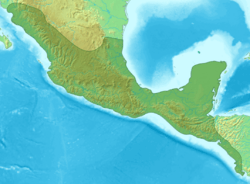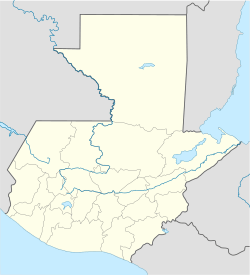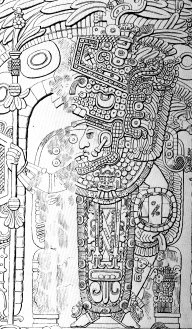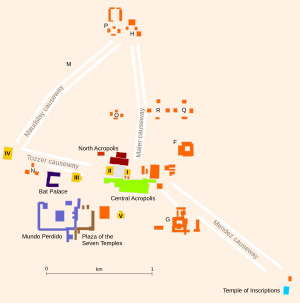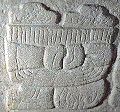Tikal facts for kids

Tikal Temple I rises 47 metres (154 ft) high.
|
|
| Alternative name | Yax Mutal |
|---|---|
| Location | Flores, Petén Department, Guatemala |
| Region | Petén Basin |
| Coordinates | 17°13′19.54″N 89°37′25.01″W / 17.2220944°N 89.6236139°W |
| History | |
| Periods | Early Classic to Late Classic |
| Cultures | Maya civilization |
| Official name | Tikal National Park |
| Type | Mixed |
| Criteria | i, iii, iv, ix, x |
| Designated | 1979 (3rd session) |
| Reference no. | 64 |
| State Party | Guatemala |
| Region | Latin America and the Caribbean |
Tikal (also called Tik’al) is the largest ancient city built by the Maya people. It is found in modern-day Guatemala at 17°13′19″N 89°37′22″W / 17.22194°N 89.62278°W. Today, Tikal is a UNESCO World Heritage Site. It is also a very popular place for tourists to visit.
Tikal was a major center for Maya culture and people. The oldest big buildings at the site are from the 4th century BC. Tikal was most powerful during the Classic Period, from 200 AD to 900 AD. During this time, Tikal was a leader in the Maya region. It had strong connections with other areas in Mesoamerica, including the city of Teotihuacan in central Mexico. After the Late Classic Period, no new large buildings were made. Some palaces were burned, and the number of people living there went down. The city was left empty by the end of the 10th century.
Contents
Exploring the Ancient City of Tikal
The ruins of Tikal are located in a lowland rainforest. Tikal did not have any natural rivers, springs, or lakes nearby. The people of Tikal collected rainwater and stored it underground. Archaeologists who worked at Tikal used these underground storage areas for their own water. It is unusual for a big city to not have natural water sources close by.
However, Tikal was successful because its people used advanced farming methods. These methods were more developed than the "slash and burn" techniques that experts first thought were used. Because Tikal depended on rainfall for water, it was at risk during times of drought. Many experts now believe that droughts played a big part in the Classic Maya Collapse. This was when many Maya cities declined.
Famous Maya Rulers of Tikal
Many rulers led Tikal throughout its history. Here are some of the known leaders and when they ruled:
Early Leaders (Late Preclassic Period)
- Yax Ehb' Xook – Around 60 AD, he was the first ruler of the Tikal dynasty.
- Siyaj Chan K'awil Chak Ich'aak ("Stormy Sky I") – Around the 2nd century.
- Yax Ch’aktel Xok – Around 200 AD.
Rulers of the Classic Period
- Chak Tok Ich'aak I ("Jaguar Paw I") – Ruled from about 360 to 378 AD. His palace was special because later rulers never built over it. It was kept in good repair for hundreds of years. He likely died when Siyaj K'ak' arrived in Tikal, possibly killed by invaders from Teotihuacan.
- Nun Yax Ayin – Ruled from 370 to 411 AD. He was a noble from Teotihuacan who became king of Tikal in 379 AD, put in power by Siyaj K'ak'.
- Siyaj Chan K'awiil II ("Stormy Sky II") – Ruled from 411 to 456 AD.
- Wak Chan K'awiil ("Double-Bird") – Ruled from 537 to 562 AD. He was captured and possibly sacrificed by the rival city of Caracol.
Later Rulers (Late Classic Period)
- Jasaw Chan K'awiil I (also known as Ruler A or Ah Cacao) – Ruled from 682 to 734 AD. He was buried in Temple I. His queen, Lady Twelve Macaw, was buried in Temple II. He won a big war against the city of Calakmul in 711 AD.
- Yik'in Chan K'awiil (also known as Ruler B) – Ruled from 734 to 766 AD. He was a powerful ruler who continued Tikal's success.
- Yax Nuun Ayiin II ("Chitam") – Ruled from 768 to 790 AD.
- Chitam II ("Dark Sun") – Buried around 810 AD in Temple III.
Harrison, Peter D. (2006). "Maya Architecture at Tikal". In Nikolai Grube (ed.). Maya: Divine Kings of the Rain Forest. Eva Eggebrecht and Matthias Seidel (assistant eds.). Köln: Könemann Press. pp. pp.218–231. ISBN 3-8331-1957-8. OCLC 71165439.
Images for kids
-
The great city of Teotihuacan in the Valley of Mexico seems to have played a big role in Tikal's politics.
See also
 In Spanish: Tikal para niños
In Spanish: Tikal para niños


